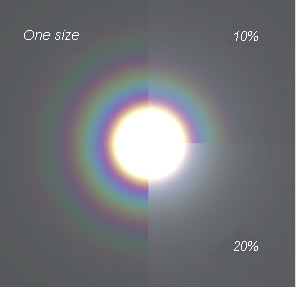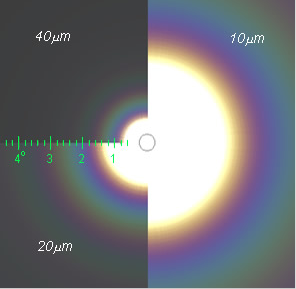Coronae - Drop size effects
Coronae - Drop Size Effects: Exploring the Phenomenon in Detail
Have you ever noticed those beautiful rings of color that sometimes appear around the sun or moon? These mesmerizing optical phenomena, known as coronae, are caused by the interaction of light with tiny water droplets or ice crystals in the atmosphere. In this article, we will delve into the fascinating world of coronae and explore the intriguing effects of droplet size on their appearance.
The Influence of Drop Size Distribution
Cloud droplets come in a variety of sizes, and this variation plays a crucial role in the visibility and contrast of coronae. When the droplet sizes within a cloud are more uniform, the corona appears more distinct. However, even a small variation in droplet size can significantly impact the appearance of coronae. For instance, a mere 10% variation in droplet size can reduce the contrast and visibility of the rings. If the variation reaches 20%, the coronae may even vanish from sight.
To gain a better understanding of these effects, researchers have conducted simulations using cloud droplets with a Normal distribution of diameters around their mean. The percentage figures used in these simulations represent standard deviations expressed as a percentage of the mean value. By studying the impact of droplet size distribution on coronae, scientists can unravel the intricate mechanisms behind these captivating atmospheric phenomena.
The Relationship between Droplet Diameter and Corona Size
One intriguing aspect of coronae is the relationship between droplet size and the size of the rings they produce. It has been observed that smaller droplets tend to produce larger coronae. To estimate the mean droplet size, one can examine the ratio of the diameter of the first ring to that of the moon.
For the red outer edge of the aureole (the region surrounding the central corona), a simple formula can be used to estimate the droplet diameter:
Drop dia,µm = 120 / aureole dia .in moon dia.
Similarly, to estimate the droplet diameter based on the diameter of the red first ring, the following formula can be used:
Drop dia,µm = 250 / ring dia .in moon dia.
These formulas provide a practical way to estimate droplet size based on observable features of coronae. By examining the relationship between droplet size and the resulting corona size, scientists can further unravel the intricate interplay between light and droplets in the formation of these ethereal phenomena.
Exploring Further Research and Resources
If you're eager to dive deeper into the world of coronae and learn more about the effects of droplet size, we recommend exploring additional resources on the topic. The original article from which this information was sourced provides valuable insights into droplet size effects on coronae. You can find the original article here.
Additionally, numerous research papers and scientific studies have been conducted on atmospheric optics, providing in-depth analyses and detailed observations of various optical phenomena. Exploring these resources can help expand your knowledge and appreciation of the intricacies of coronae and other mesmerizing atmospheric displays.
Conclusion: Unraveling the Intricacies of Coronae
Coronae, those enchanting rings of color encircling the sun or moon, are a captivating sight that has fascinated scientists and sky gazers for centuries. By understanding the effects of droplet size on coronae, we gain valuable insights into the mechanisms behind their formation and appearance. The variation in droplet size within clouds directly impacts the visibility and contrast of coronae, with even slight deviations affecting their distinctness. Furthermore, smaller droplets tend to produce larger coronae, allowing us to estimate droplet size based on observable features.
As we continue to explore the mysteries of atmospheric optics, further research and resources provide a wealth of information to delve deeper into this fascinating subject. By delving into the original article and exploring additional scientific literature, we can gain a more comprehensive understanding of the intricate interplay between light and droplets in the creation of these mesmerizing atmospheric phenomena. So, the next time you spot a corona encircling the sun or moon, take a moment to appreciate the hidden world of droplet size effects that contribute to its ethereal beauty.

Drop size distribution
When cloud droplets have a variety of sizes the corona is less distinct. A 10%. variation reduces ring contrast and visibility. 20% is enough to make them disappear.
. In these simulations the cloud droplets are given a Normal distribution of diameters about their mean. The percentage figures are standard deviations expressed as a percentage of the mean value..

Droplet diameter
Smaller droplets produce larger coronae. Estimate the mean droplet size from the ratio of the diameter of the first ring to that of the moon.
Red 1st ring (more reliable):
Drop dia,µm = 250 / ring dia .in moon dia.
For the red outer edge of aureole:
Drop dia,µm = 120 / aureole dia .in moon dia.
Note: this article has been automatically converted from the old site and may not appear as intended. You can find the original article here.
Reference Atmospheric Optics
If you use any of the definitions, information, or data presented on Atmospheric Optics, please copy the link or reference below to properly credit us as the reference source. Thank you!
-
<a href="https://atoptics.co.uk/blog/coronae-drop-size-effects/">Coronae - Drop size effects</a>
-
"Coronae - Drop size effects". Atmospheric Optics. Accessed on December 22, 2024. https://atoptics.co.uk/blog/coronae-drop-size-effects/.
-
"Coronae - Drop size effects". Atmospheric Optics, https://atoptics.co.uk/blog/coronae-drop-size-effects/. Accessed 22 December, 2024
-
Coronae - Drop size effects. Atmospheric Optics. Retrieved from https://atoptics.co.uk/blog/coronae-drop-size-effects/.